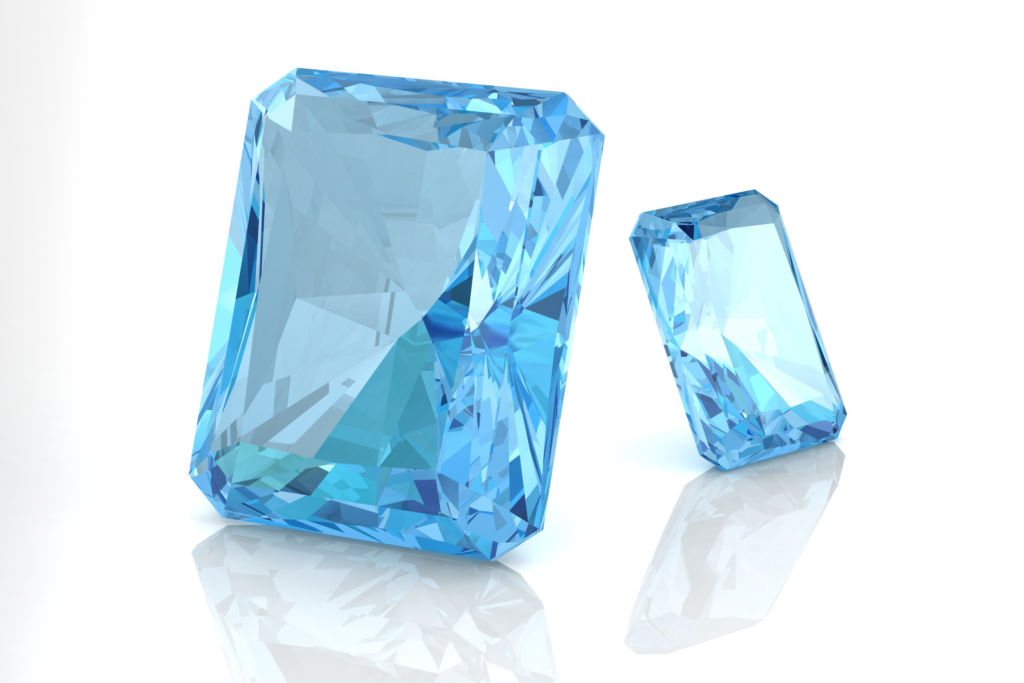
The value of Aquamarine gemstones is very much determined by their aesthetics. As with most gemstones the 4C’s of cut, color, carat, and clarity all come into play when pricing this gemstone.
What is the best color for Aquamarine gemstones?
Color is probably one of the more important determinants of Aquamarine value. The richer and darker toned the color of the Aquamarine, the higher its value. A piece that is radiant sky blue will be more than twice the price of a piece that has a faded hue, even if they both have the same quality of cut, clarity, and carat weight. These pieces are rare and highly valuable, and are some consider them a sound investment for the jewelry portfolio.
Stay away from Aquamarine that is pale or almost white with hints of blue around the edges, even if they are well-cut, large in size, and have great clarity – color means much more to Aquamarine’s value than size!
Do Aquamarines have a lot of inclusions?
Aquamarines, unlike their Emerald cousins, are often highly clear, transparent gemstones that can be easily cut to increase its natural sparkle. As such, Aquamarine gemstones with good clarity are not rare and can be obtained for a reasonable price. A milky, spotted, or “cracked-looking” piece of Aquamarine is of much less value and should be priced accordingly. High quality pieces of Aquamarine are completely clear of inclusions, and cut in fashion that reflects maximum light.
What is the best cut for Aquamarine gemstones?
The Emerald or step cut is the most popular style for pieces of Aquamarine, particularly when placed in ring settings. Regardless of style, the cut of an Aquamarine stone should take advantage of the inherit clarity of this gem and make it sparkle. This is a highly reflective gemstone but a poor cut can dull the lustre of even a gem with exceptional clarity. In order to make the most of Aquamarine’s reflective nature, the angles should be sharp and straight, and keep the light contained within the jewel. The facets of the gem stone should be symmetrical and appealing to the eye.
A poorly cut piece of Aquamarine will be uneven or irregular, and the shape may be distorted. Light will “seep” from the sides of the gem rather than being directed straight into the viewer’s eye. A poorly cut piece of Aquamarine can still be attractive – particularly if the color is strong – but the value is much less.
How much is a 1-carat Aquamarine worth?
Aquamarine is relatively inexpensive and often found in large pieces. Because of this, it’s easy for jewelers to do away with the impure parts of the stone and you will easily find a good quality, well-cut, small piece of Aquamarine jewelry for a moderate price (which is why they are a great gift idea). In fact, it’s not unheard of to find a 1 carat, well-cut piece of Aquamarine with strong color for under $100. When it comes to value, the size of an Aquamarine gem is not nearly as important as its color and clarity. A large piece (say, over 10 carats) that has inclusions and a pale color is worth far less than a gem half its size that is transparent and rich in blue coloring.
Aquamarine Uses, History & Legend
Aquamarine has historically been used by soldiers to prevent fear on the battlefield, as it is said to promote bravery. Sailors carry the gemstone as a protection against drowning and to deflect the evil energies of negative spirits. In more modern times, students use Aquamarine to enhance study as it is said to improve memory and rid the brain of useless information, while improving clarity and concentration.
Aquamarine is used in crystal healing to soothe the nervous system. It is calming, cooling and regenerative, and used to help with conditions such as nervous tension, anxiety, stress, and fear. For the physical body, it is said that wearing Aquamarine can heal varicose veins, conditions of the liver, and improve the functioning of the thyroid, kidneys, and spleen.
As part of a jewelry collection, Aquamarine gemstones are best worn at night. Before buying, be sure to look at the stone in daylight, and if it looks good in daylight, it can only get better at night under incandescent light.
